Case Study: How an Ecommerce Site Increased Search Traffic by 1780%
Today, I am going to show you the exact keyword research method I used to rank a medical ecommerce site for multiple high volume search terms. Ecommerce Site Increased Search Traffic
We’re not talking about slouch keywords, either. Some of these keywords have over 3,000 searches per month. Not to mention, they now outrank authoritative medical websites like Mayo Clinic and WebMD. Ecommerce Site Increased Search Traffic
No link building, no paid traffic, no social media, no dark-colored hats.
Don’t get me wrong, I am a BIG advocate of link building and content promotion. But this client simply didn’t have a WebMD budget, so advanced SEO was out of the question. Ecommerce Site Increased Search Traffic
Despite having a decent backlink profile, my client’s organic traffic was flat and puny. How did I turn this site around by only updating one page? The Double Jeopardy Technique. Ecommerce Site Increased Search Traffic
In this case study, I am going to show you exact process I used to put this ecommerce site on Google’s map.
How The Double Jeopardy Technique Skyrocketed Organic Traffic
For a long time, the only source of traffic for this ecommerce site was paid search. Since using The Double Jeopardy Technique, their site ranks in the top 3 for 46 keywords totaling over 16,000 searches per month.
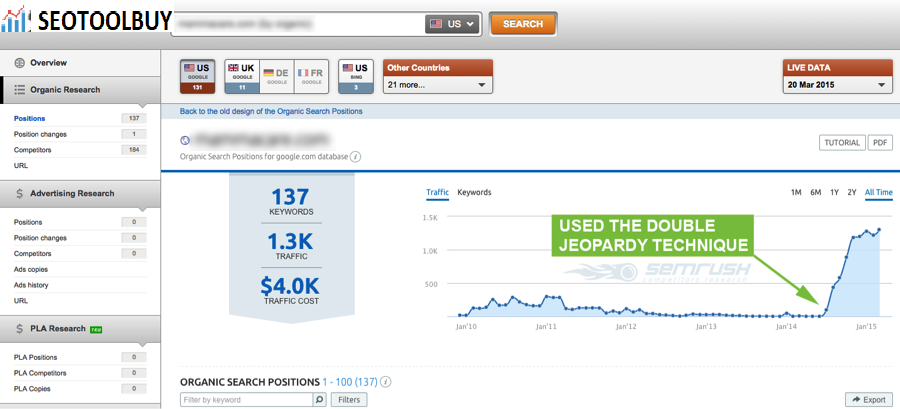
On top of that, their organic traffic increased by 1780% since using this technique. They also rank in the top 20 for over 128 keywords. This one blog post now accounts for over 93% of their traffic.
Here are the exact steps you can take to use The Double Jeopardy Technique for your ecommerce site.
- Step 1: Use Google Keyword Planner (GKP) to find informational keywords
- Step 2: Find your base keyword with Semrush
- Step 3: Find your best content for that keyword
- Step 4: Forum research
- Step 5: Make your content an answer
Let’s take a look at each step in depth.
STEP 1: Find Informational Keywords Related To Your Product
If you’ve ever done SEO for ecommerce, you know how tough it can be to generate organic traffic that actually moves products. This is why the Double Jeopardy Technique starts with your product page. The trick is to use Google Keyword Planner to find informational keywords related to your product.
Add “Jeopardy Terms” Keywords To Plan
- Enter your product page URL into GKP
- Include when, where, why, what, how and tips as required terms
- Sort results by search volume
- Add relevant keywords to your plan
- Copy the keywords from your plan to your clipboard
This will show you the informational keywords that Google relates to your product. Time after time, I have been able to rank all these terms on a single blog post and send the traffic to a product page with an internal link.
Most ecommerce sites focus way too much on transactional keywords. You know, those super competitive terms like “Buy Product Name” that eat up all your PPC budget.
Content with informational keywords are:
- Easier to rank for
- Result in more traffic
- Easier to build links to
- Helpful to building customer trust
STEP 2: Find Your Base Keyword with Semrush
Hopefully, you’ve copied over at least a dozen of keywords from GKP. Now it is time to check the keyword difficulty and select your base keyword.
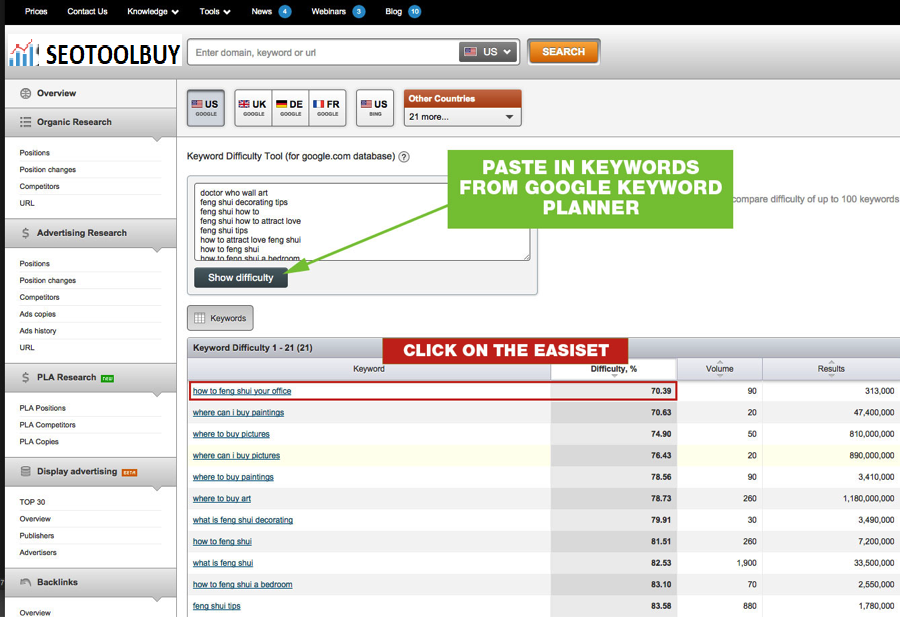
- Paste keywords from GKP into Semrush’s keyword difficulty tool.
- Click on the least difficult keyword.
- In the organic results section, click on the first few listings.
- Export semantic keywords from top ranking pages.
- Check the difficulty of high volume keywords to see if there is a better option.
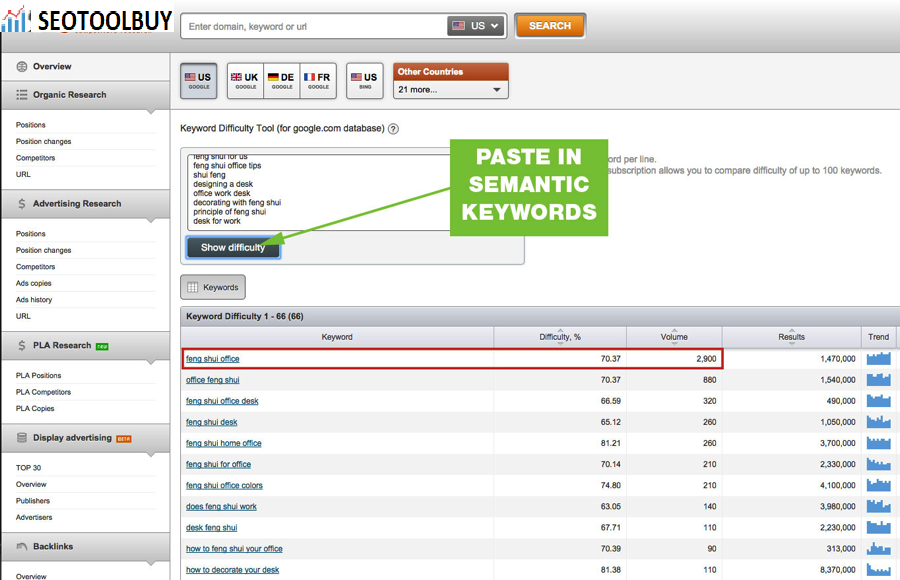
“Feng shui office” makes a great base keyword in this example
Unfortunately, there isn’t a magic formula for finding that sweet spot keyword. Unless you have a high domain authority, you want to avoid the most difficult keyword. The reason you want to do steps 3-5 is to understand how Google groups keywords together.
We also want to see if we can find better keywords that GKP missed. In other words, a website might rank for a keyword related to your informational keywords that have higher search volume and less difficulty.
STEP 3: Find Your Best Content For That Keyword
Once you have your base keyword, use Google site search to find which content has the best chance of ranking.
“Low Difficult Keyword” site:yourdomain.com
You want to find content that is not getting a lot organic search traffic. You should use Semrush to check if any of these pages rank for keywords.
An old blog post that doesn’t rank for anything is an ideal page. We’re going to kill that page and create a better version of it.
STEP 4: Research Forums
When people search on Google they have a psychological need. I think a lot of times, search marketers forget that. When you eavesdrop on conversations from real people, you’ll have a deeper understanding of what your content should accomplish.
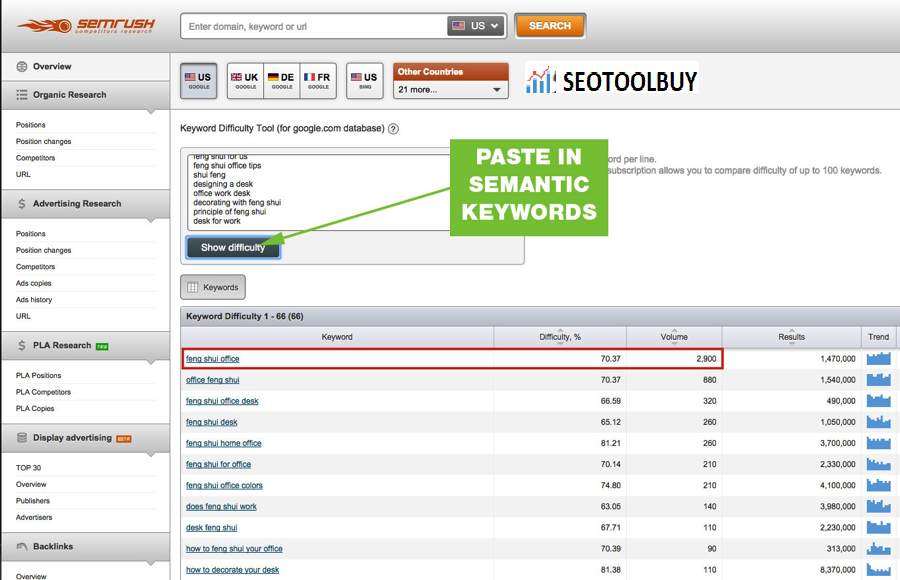
“Feng shui office” makes a great base keyword in this example
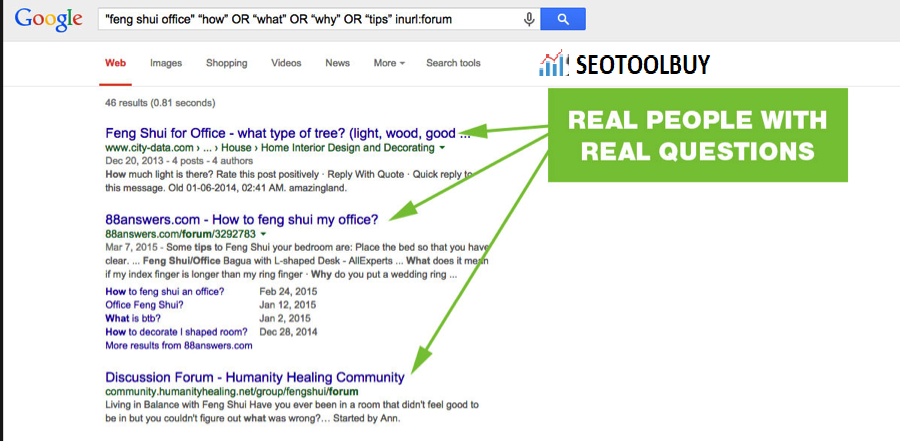
Search marketing is about matching up your page with your customers’ intent. You can’t understand someone’s intent by simply crunching keyword data. Since most of our keywords are in the form of a question we can type them straight into Google to find answers.
“base keyword” inurl:forum
For narrower results,
“base keyword” “how” OR “what” OR “why” OR “tips” inurl:forum
Forum research helps you:
- Understand how real people talk about your topic.
- Learn about your customer’s pain points.
- Fill in gaps in your own content with ideas from passionate people.
- Humanize your content.
STEP 5: Update Your Content
Google wants to rank content that matches search intent. Their business depends on this.
For my client’s site, most of the content was already written. It was just in the form of several thin blog posts that lacked any keyword focus. This is where The Double Jeopardy Technique comes in.
We’re sending the same content to Google to judge for a second time. On this trial, you’ll have a better defense (improved keywords and customer insight).
If writing isn’t your thing, hire a freelance writer. The important thing is to send them the base keyword, semantically related keywords, questions your content should answer, links to any forums and your current content to repurpose.
Once you get the content back from a writer, you want to:
- Include the base keyword (only) in the URL.
- Include your base keyword in the Page Title, H1.
- Include semantically related keywords in other headings and body copy.
- 301 redirect the original blog post(s) to the new page.
- Add a link to your product page in the first 100 words.
In this case study, I actually redirected several thin (250 word) blog posts to the newly written article. This helps avoid keyword cannibalism and consolidates PageRank.
Over To You! Ecommerce Site Increased Search Traffic
When you focus too much on transactional keywords, you’re missing a golden opportunity to get search traffic from potential customers. The Double Jeopardy Technique is the fastest way to find informational keywords for your products and update a weak ecommerce blog.
I’ve used the same tactic on three other ecommerce sites this year alone. It works. Give it a try and let us know your thoughts on this tactic in the comments.
Want to learn more about ecommerce content marketing? Check out my free course.




drunk driving statutes inside Ohio might be intricate, and yet it’s important to need a good understanding of these individuals if your find yourself complaints. Driving under the influence of alcohol (DUI) are a serious criminal offenses which can have substantial ramifications on their life. In Ohio, some sort of lawful threshold for blood stream alcohol content (BAC) is 8 percentfor the majority drivers and additionally four per cent business racers.
If you are stopped by police administration and suspected of DUI, they might make roadside sobriety checks or substance checks, like seeing as breathalyser or body checks, to ascertain your own level of impairment. Declining these tests can lead to natural sanctions, including license suspension.
drunk driving criminal acts in Ohio possess multiple penalties, according on variables which include earlier judgment of conviction, BAC degree, and/or it doesn’t matter if around was ever an crash or harm concerned. Results may put charges, license pause, vital alcohol process applications, liberation, and perhaps offender time. Reiterate criminal acts and annoyed cases can result in more very bad consequences.
Providing a experienced DUI safety attorney is crucial to navigate the complexities of Ohio ovi laws. They may review the explanation, fight the lawfulness of the halt, matter the dependability of examinations, and examine potentially interested defenses to help abate the allegations. Additionally, an legal representative can advise you by using the appropriate process, making sure of ones liberties are insulated and advocating for the optimum likely end.
Keep in mind, being well informed with regards to Ohio’s DUI statutes and looking for the assistance of an knowledgeable legal representative are significant steps in nicely management a DUI accusation and guarding any forthcoming future.
[url=https://www.bouchardcincinnaticriminalduiattorney.com/practice-areas/sealing-records/]kid abuse counselor in Dayton Ohio[/url]
OVI statutes to Ohio could be complex, but it’s crucial to have got a solid understanding of any of them if that you find yourself allegations. Driving under all influence of alcohol (DUI) was a grave crime which can own notable ramifications on a future. In Ohio, will legal limit for bloodstream alcohol content (BAC) is 8%for maximum drivers furthermore 4 percent business racers.
If you might be stopped by legal enforcement and suspected of drunk driving charge, they may carryout roadside temperance studies or substance examinations, really just as breathalyser or blood testing, to ascertain their degree of harm. Refusing these tests can cause auto penalties, including driving license suspension.
driving while intoxicated offensive activity in Ohio hold various penalties, based upon on factors enjoy before judgment of conviction, BAC stage, and even if present would be an fluke or accident required. Risks might include fines, license temporary removal, mandatory liquor method workouts, probation, and uniform jail time. Duplicate criminal acts and intensified concerns can cause more harsh consequences.
Getting a knowledgeable DUI defensive attorney is vital to navigate the challenges of Ohio DUI statutes. They is able to examine the indication, challenge the legalization of the stop your vehicle, concern the consistency of assessments, and check out capacity resistance to help decrease the costs. Likewise, an attorney can advise you by the judiciary process, affirming your very own legal rights are guarded and urge for the right conceivable impact.
Keep in mind, being notified regarding Ohio’s DUI regulations and trying the support of an encountered solicitor are significant actions in nicely holding a DUI rate plus covering their destiny.
https://www.bouchardcincinnaticriminalduiattorney.com/practice-areas/top-cincinnati-ohio-dui-ovi-attorney-roger-bouchard/